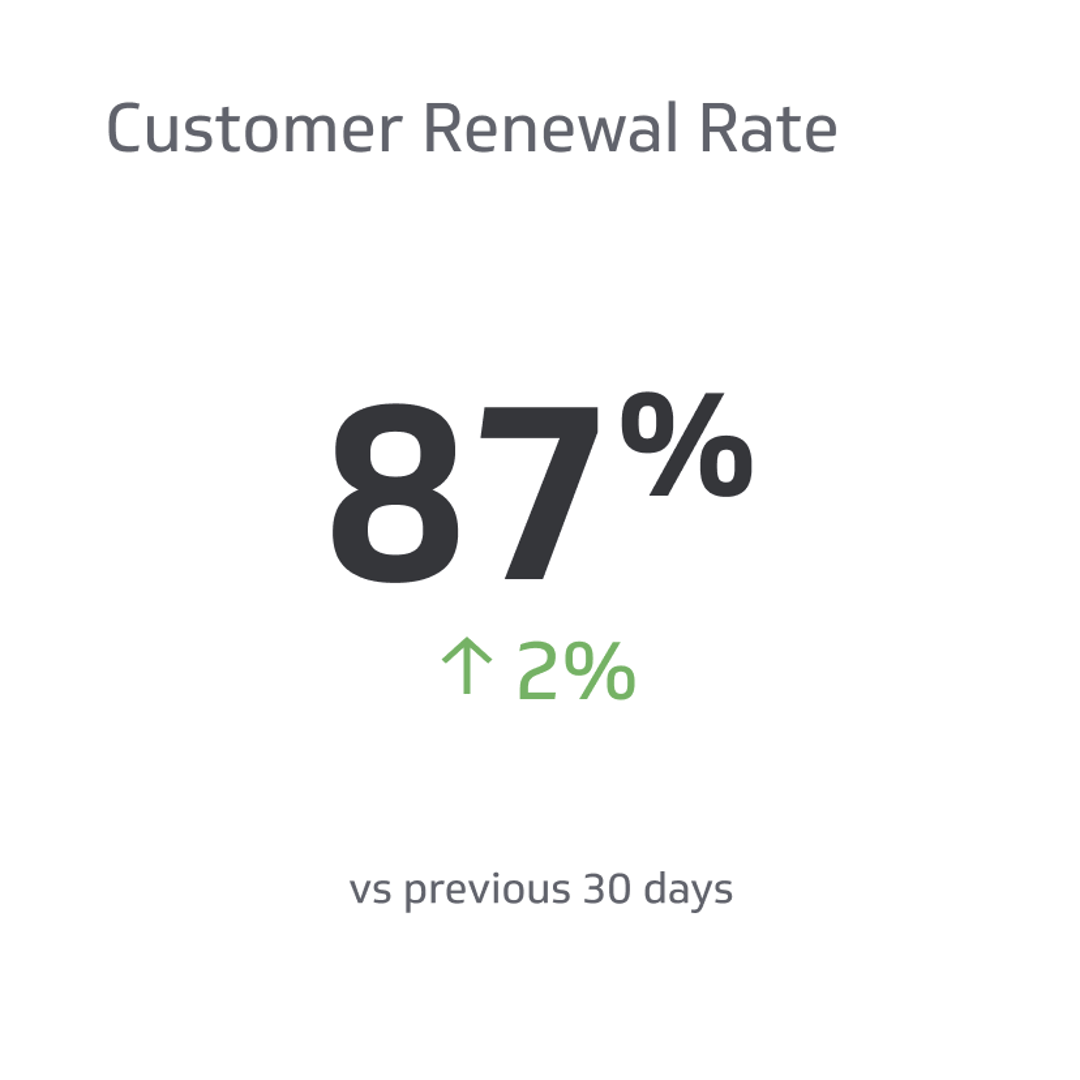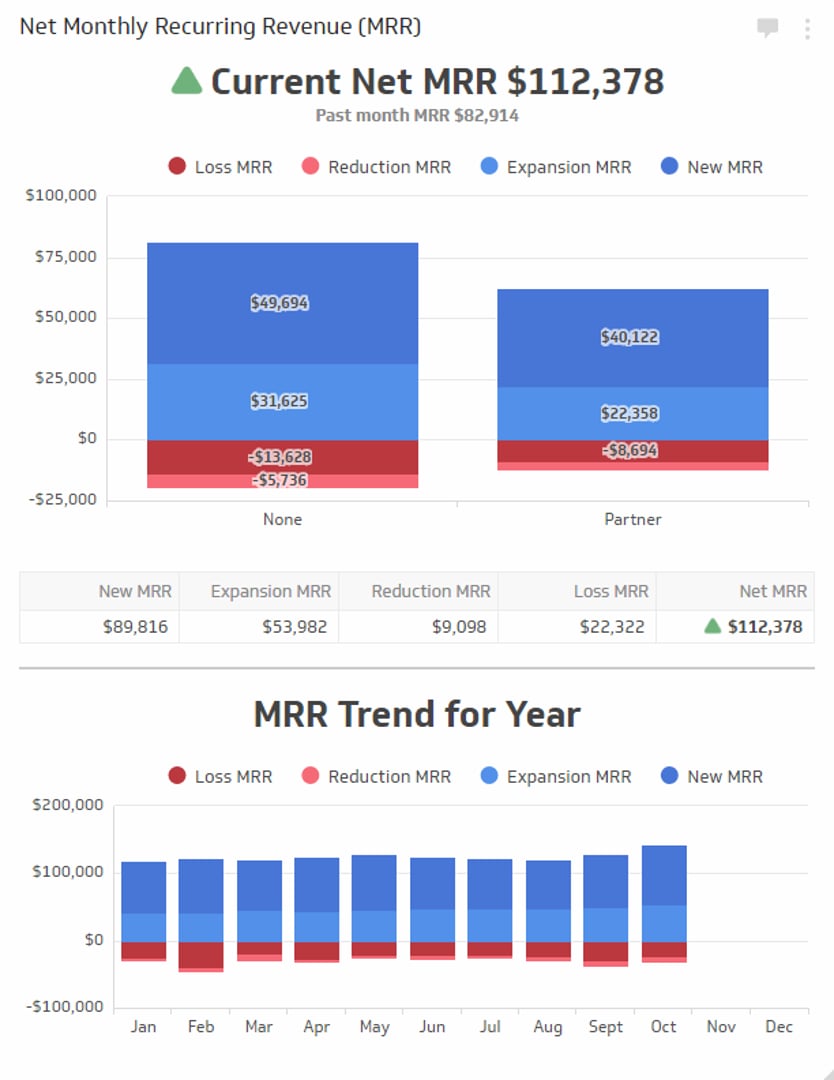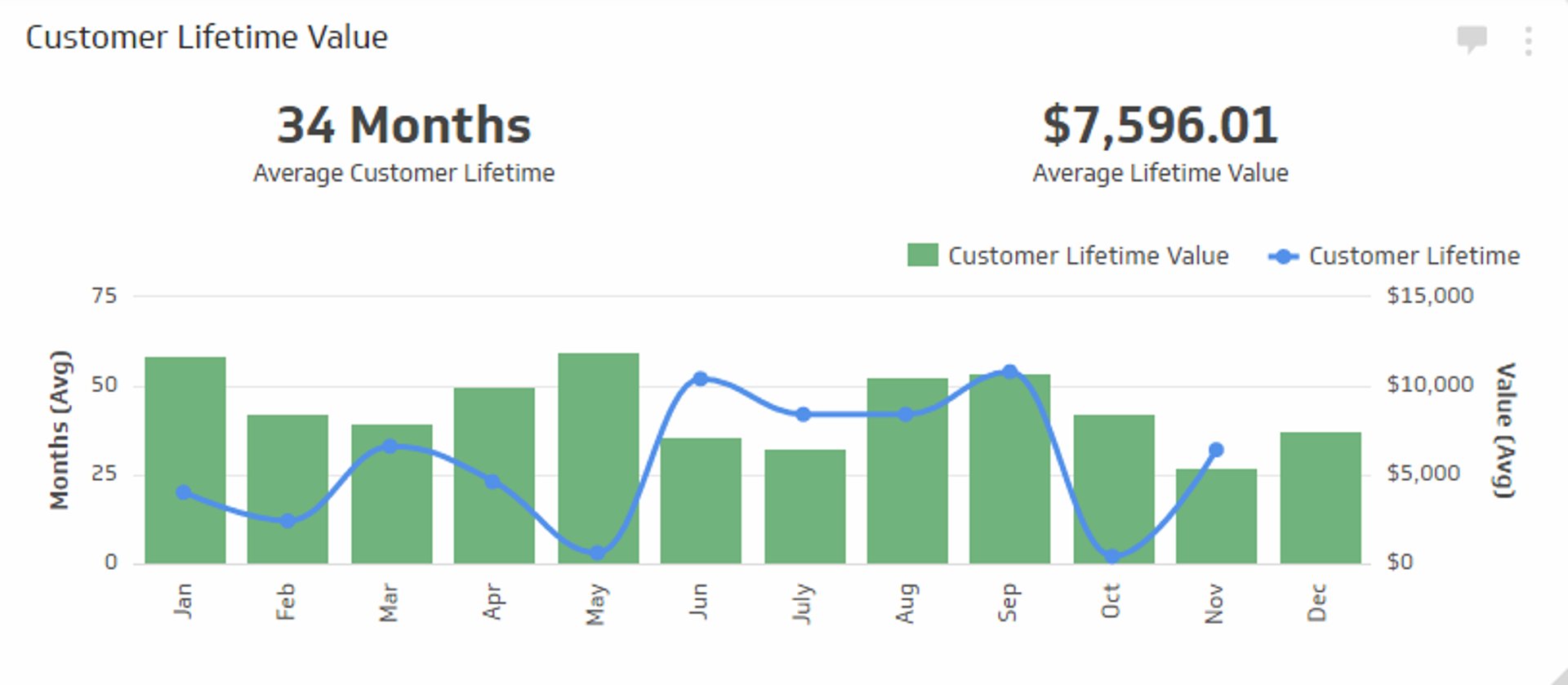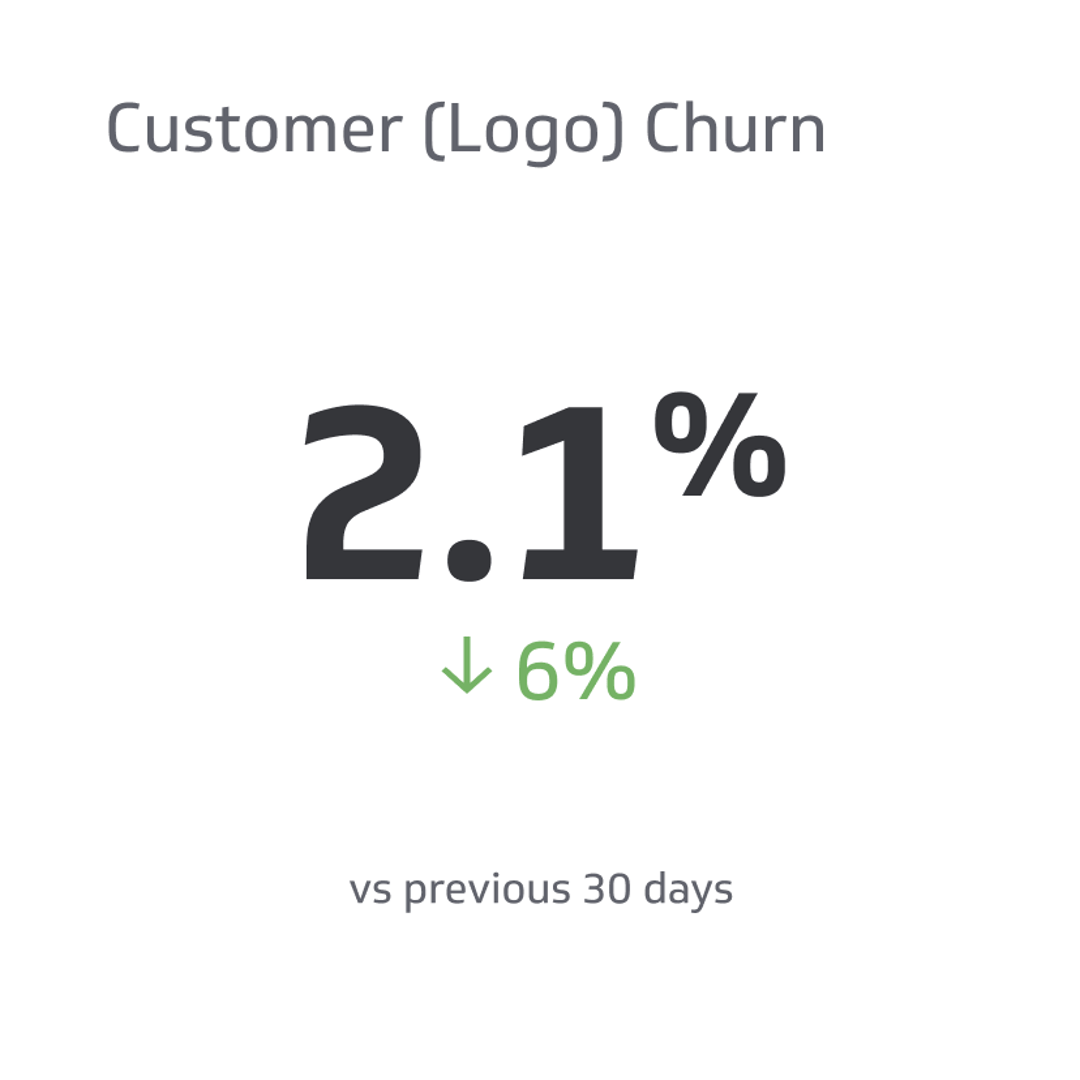Customer Renewal Rate
Customer Renewal Rate measures the proportion of customers who renew their subscription or contract at the end of a specified period.
Track all your SaaS KPIs in one place
Sign up for free and start making decisions for your business with confidence.

In today's competitive business landscape, retaining customers is essential for success. One key metric that gauges the effectiveness of your customer retention strategies is Customer Renewal Rate - a powerful indicator revealing how well your company maintains its customer base and generates long-term revenue.
This blog post will demystify what Customer Renewal Rate is and why it matters and provide you with the tools to calculate and optimize this metric for business success.
Understanding Customer Renewal Rate
Customer Renewal Rate measures the proportion of customers who renew their subscription or contract at the end of a specified period. Tracking this rate helps businesses understand how well they are satisfying their customers and can help them identify potential areas for improvement.
Definition And Importance
Customer Renewal Rate, also known as Renewal Rate, tracks the proportion of customers who choose to renew and extend their contracts or subscriptions at the end of a specific period.
Understanding Customer Renewal Rates is exceedingly important because they tell businesses if they satisfy their customer base enough to keep them coming back for more. Even the slightest bump in customer retention can have a massive impact on the bottom line, a 5% improvement can create between 25% and 95% more revenue.
Factors That Affect Renewal Rate
Several factors can influence a customer's decision to renew their subscription or contract, and businesses must address these elements proactively. The primary influencers across all industries include quality of service, overall satisfaction, trust, and commitment.
Digging deeper, it’s necessary to understand that pricing is the common denominator and a marker that can affect all four factors. Offering competitive prices for your product or service is necessary and underscores not just the commitment to delivering quality but also establishing trust and a commitment to your customers.
Personalizing customer interactions through tailored communication strategies, such as segmented email marketing campaigns or targeted promotions based on user behavior, can further contribute positively to higher renewal rates.
Benefits Of Tracking Renewal Rate
Tracking customer renewal rates is one of the top key performance indicators (KPIs) to track if you want to improve your bottom line. By monitoring this KPI, companies can identify the effectiveness of their products, services, and marketing strategies in long-term customer retention.
Additionally, tracking renewal rates allows businesses to spot patterns and trends that may help refine their retention efforts. Identifying areas where improvements are needed can lead to increased revenue growth through enhanced customer experience and loyalty.
Understanding these metrics also aids in predicting future business success by revealing how likely current customers are to remain engaged with the organization for an extended period.
How To Calculate Customer Renewal Rate
To calculate the customer renewal rate, simply divide the number of customers or contracts renewing at the end of a specific period by the total amount, then multiply it by 100 to get an accurate percentage.
Knowing how to calculate this metric is crucial because it helps businesses anticipate future sales and revenue growth. It also provides valuable insights into customer satisfaction levels and identifies opportunities to improve retention strategies further.
Real-World Examples
Suppose a company provides an online streaming service with monthly subscriptions, and at the end of June, 500 customers decide to renew their subscription for another month.
The total number of subscribers in June was 1,000. To calculate the renewal rate, we divide 500 by 1,000 and multiply the result by 100 to get a renewal rate of 50%.
Another example could be a software provider that sells annual contracts to its clients. At each contract's expiration date, they received renewal invoices automatically generated through an accounting system within their software product.
If out of every 10 expiring contracts, only six are renewed each year, then this business has an annual gross renewal rate (GRR) of 60%.
Interpreting The Results
Interpreting the results of your customer renewal rate calculation can provide valuable insights into the health of your business.
While it’s not common to have a 100% renewal rate, a high percentage indicates that a company consistently meets customer expectations and encourages loyalty. On the other hand, low renewal rates may signal areas for improvement, such as pricing strategy or overall customer experience.
To improve customer retention and increase the renewal rate, businesses should focus on identifying areas for improvement based on customer feedback and addressing any concerns promptly.
Why Analyzing Renewal Rate Is Crucial For Businesses
Analyzing renewal rates is key to identifying customer satisfaction levels, predicting future business success, impacting revenue growth, and recognizing the importance of retaining customers.
Impact On Revenue Growth
Retaining more customers allows companies to generate consistent and predictable revenue streams, leading to long-term business success.
For example, imagine a SaaS company that has 1000 customers paying $50 per month. If their renewal rate is 80%, they will retain 800 customers, generating a monthly recurring revenue of $40,000.
Analyzing and improving the customer renewal rate translates to stable and sustainable growth leading to increased profits over time.
Importance Of Customer Retention
One of the key benefits of tracking Customer Renewal Rates is its impact on customer retention. Acquiring new customers can be up to five times more expensive than retaining existing ones, making customer retention an essential part of a business's revenue growth strategy.
By accurately calculating and analyzing renewal rates, businesses can identify potential areas for improvement and develop strategies to improve customer loyalty and increase their chances of renewing contracts or subscriptions.
A high Customer Renewal Rate indicates that the company has delivered quality services/products leading to satisfied customers who are highly likely to continue doing business with them.
Identifying Customer Satisfaction Levels
Understanding how satisfied your customers are with your product or service helps you identify areas for improvement so that you can retain more loyal customers.
This can be done through methods such as collecting feedback surveys from customers, analyzing social media comments and conversations, and monitoring Net Promoter Score (NPS).
For instance, if the NPS score is low or negative, it indicates that a company needs to work on improving its services to earn more positive responses from customers.
Predicting Future Business Success
Calculating Customer Renewal Rates enables businesses to predict future success by providing insights into the level of customer satisfaction and loyalty. A high renewal rate can indicate that a company is offering quality products or services, leading to happy customers who are likely to renew their contracts in the future.
For example, if a SaaS business notices a sudden drop in its renewal rate during a particular quarter, it could signal an issue with product updates or poor customer experience.
Identifying these issues early on allows companies to take necessary actions quickly and adjust strategies accordingly, resulting in greater customer retention and long-term success.
Strategies To Improve Customer Renewal Rate
To improve Customer Renewal Rates, businesses can implement strategies such as providing outstanding customer service, offering incentives and discounts, personalizing customer interactions, addressing feedback and concerns, and measuring success.
Providing Outstanding Customer Service
One strategy for improving Customer Renewal Rate is by providing exceptional customer service. Customers are more likely to continue using a product or service if they receive quality assistance and support from the company.
This includes prompt responses to queries, providing relevant information, resolving issues quickly, and being friendly and helpful throughout the interaction. For instance, a software company can provide customers with detailed user guides or tutorials on how to troubleshoot certain problems.
Furthermore, companies that prioritize excellent customer service tend to have higher Net Promoter Scores (NPS) - an index calculated based on how likely customers are willing to recommend their product/service to others.
Offering Incentives And Discounts
Another strategy to improve the customer renewal rate is by offering incentives and discounts. Customers love to feel appreciated, and providing them with special deals or exclusive content can strengthen their loyalty to your brand.
For example, you could offer a discount on future subscriptions for customers who renew their contracts early or provide them with complimentary upgrades as part of the renewal process.
It's important to note that while incentives and discounts can be effective ways to retain customers, they shouldn't become the sole focus of your renewal strategy. The real value lies in addressing any underlying issues that may be impacting customer satisfaction in the first place.
Personalizing Customer Interactions
One of the best ways to improve your customer renewal rate is by personalizing customer interactions. Customers want to feel valued and appreciated, so taking the time to understand their needs and preferences can go a long way in building loyalty.
One effective approach is to segment your customers based on their demographics, behaviors, and purchasing habits.
For example, let's say you run a fitness studio that offers various classes such as yoga, pilates, and strength training. By tracking each member's attendance patterns and class preferences, you can personalize their experience by recommending similar classes or providing targeted promotions based on what they enjoy most.
In addition to segmentation, businesses should also aim to provide personalized support through channels such as social media or email marketing campaigns.
Overall, personalization is useful when it comes to enhancing your relationship with customers and improving renewal rates.
Addressing Customer Feedback And Concerns
When it comes to improving customer renewal rates, addressing customer feedback and concerns is an important step. Customers are more likely to renew their subscriptions or contracts when companies go above and beyond to address their service needs.
For example, if a customer expresses dissatisfaction with a product feature or service offering, a business should take steps to address the issue. This could mean making improvements to the product based on customer suggestions or providing additional training for employees to ensure better service delivery.
Measuring And Tracking Success
Measuring and tracking success is crucial for businesses looking to improve their customer renewal rate. By monitoring your KPIs, such as customer satisfaction levels, retention rates, and revenue growth, you can gain valuable insights into how well you are retaining customers.
To track the success of these improvements, use data analytics software to monitor your key SaaS metrics like churn rate and subscription renewal rate.
Overall, measuring and tracking success allows businesses to make data-driven decisions that positively impact their bottom line by improving their renewal rate and increasing long-term revenue.
Conclusion
Having a solid understanding of Customer Renewal Rates is essential for businesses that rely on customer retention and subscriptions. By tracking this KPI, companies can tailor their strategies to improve customer experiences and increase loyalty, leading to long-term revenue growth.
Remember that factors such as competitive pricing, exceptional services, and personalized interactions can all impact the renewal rate. By utilizing effective measurement tools and analyzing the data regularly, businesses can make informed decisions that will help them succeed in today's market.



 Churn.png)